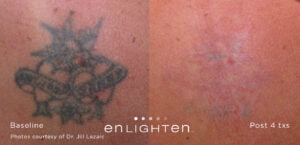Thinking about removing a tattoo? You’re not alone.
Tastes change. Life circumstances shift. What once felt meaningful may no longer reflect who you are. Laser tattoo removal offers a way to reduce or eliminate unwanted ink with care and precision. But before starting treatment, it helps to understand what’s involved.
Here are 10 things to know about our tattoo removal in Columbus—from how it works to what you can expect during the process.

1. Tattoo removal takes time
One session won’t remove your tattoo. Complete removal usually requires multiple treatments. On average, full removal varies based on ink and your bodies response to breaking down the ink in that area. on average it can take between 8 to 12 or more treatments, with time between treatments ranging between 6 to 10 weeks depending on recommendations of your practitioner. The time between sessions gives your skin time to heal and allows your body to flush ink particles.
Each session builds on the last. Pushing the process faster risks damaging the skin or leading to uneven fading.
2. Laser technology breaks up ink particles
Laser tattoo removal works by using a focused beam of light to break tattoo ink into smaller fragments. Your body’s immune system then slowly removes these particles over time. Different laser wavelengths target different colors of ink. That’s why professionals often use two or more laser types during treatment.
Newer technologies, like picosecond lasers, can break down ink faster and with less heat, which may reduce skin irritation compared to older laser systems.
3. Some colors are harder to remove
Black ink responds best to laser treatment because it absorbs all wavelengths. Other colors like green, blue, and yellow are more resistant. Removing colored tattoos may take more sessions than removing black ones.
In some cases, certain shades may not respond to one laser and require a different wavelength altogether to see progress.
4. Skin type affects results
Skin tone plays a role in how the skin absorbs laser energy. Lighter skin generally tolerates higher laser settings with fewer complications. Darker skin requires customized settings to prevent pigment changes or burns. A qualified provider adjusts treatment based on your Fitzpatrick skin type.
Laser choice and technique matter even more for darker skin, making experience with diverse skin types essential.
5. Not all tattoos can be removed completely
While most tattoos fade significantly, some may leave behind faint shadows or white ghosting. Older tattoos often break down faster than newer ones. Amateur tattoos are less predictable since they’re applied with different pressure and ink depth.
Ink composition also matters. Some pigments contain metallic elements that reflect light or resist breaking down, which can limit outcomes.
6. Tattoo removal has risks
Laser tattoo removal is generally safe when performed by trained professionals, but side effects can occur. These may include redness, swelling, blistering, and temporary skin lightening or darkening. In rare cases, permanent scarring or pigment changes can develop.
Following aftercare instructions closely and choosing a licensed provider help reduce these risks.
7. It feels uncomfortable
Most people describe the sensation as similar to a rubber band snapping against the skin. The level of discomfort depends on the location of the tattoo and individual tolerance. Clinics can apply numbing cream or use cold air devices to make sessions more tolerable.
The pain usually lasts only during the procedure and fades quickly afterward.
8. Aftercare is essential
Healing well between sessions affects your results. After each treatment, you’ll need to keep the area clean, apply ointment, and avoid direct sun. Icing the area helps manage swelling. Avoid hot showers, tight clothing, or heavy exercise for at least 24–48 hours.
Infected or irritated skin can delay healing and increase the chance of scarring, so stick to your provider’s guidelines.
9. Tattoo removal isn’t cheap
Costs depend on factors like size, location, color, and the number of sessions needed. Small black-ink tattoos may cost less, while large or colorful pieces often require more time and expense. Most clients spend several hundred to several thousand dollars over the course of treatments.
Be wary of clinics offering unusually low pricing—cutting corners with equipment or training raises safety concerns.
10. Results rely on the provider’s skill
Laser tattoo removal is a technical procedure that requires training and experience. Skill affects how the laser is used, how your skin reacts, and how well the ink breaks down. Poor technique may lead to scarring, unnecessary pain, or incomplete fading.
Ask about your provider’s credentials, equipment, and experience before starting treatment.
Additional Factors That Affect Tattoo Removal
Tattoo removal is not one-size-fits-all. Several factors beyond laser technology and ink color can affect how your skin responds and how well a tattoo fades. Understanding these details helps set realistic expectations before starting treatment.
Initial consultation sets the foundation
Before starting laser sessions, you’ll attend a consultation. Your provider will examine the tattoo, review your medical history, and assess your skin type. They’ll also look at factors like tattoo depth, placement, and ink colors. These details help determine how your skin may respond and how many sessions you might need.
This is your chance to ask questions. If any part of the process feels unclear, speak up. Understanding what lies ahead helps avoid surprises.
Health conditions can affect the outcome
Laser tattoo removal isn’t appropriate for everyone. If you have certain skin conditions like eczema or a history of keloid scarring, your provider may adjust treatment—or recommend against it. Pregnancy, current infections, and some medications can also affect healing and safety.
Always be honest about your health history. This helps avoid complications and makes the treatment plan safer and more effective.
Full removal isn’t always the goal
Some people want complete removal. Others just want to lighten a tattoo so they can replace it with a new design. This is sometimes called tattoo fading. Fewer sessions are needed, and the goal is simply to create a good base for a cover-up, not to erase the ink entirely.
If that’s your goal, talk to both your tattoo artist and your laser provider. Fading gives the artist more flexibility and often improves results.
You need to wait between sessions
Spacing treatments six to eight weeks apart is a key part of laser tattoo removal. This gap gives your body time to break down ink particles and allows the skin to heal fully. Trying to rush the process won’t speed up results and may lead to side effects like blistering or irritation.
Following the right schedule gives you better long-term results and protects your skin.
Choosing the right provider matters
Laser tattoo removal requires technical skill and the right equipment. Look for a clinic that uses Q-switched or picosecond lasers. These types of lasers are designed for tattoo removal and use shorter pulses that minimize skin damage. Your provider should also have experience working with your skin type.
Ask about training, equipment, and credentials. A licensed, well-trained provider will explain your options clearly and avoid overpromising.
Tattoos fade differently based on location
Where your tattoo is on your body can affect how well it fades. Areas with better blood flow—like the chest or upper arms—tend to respond faster. Tattoos on the hands, feet, or lower legs may take more time because circulation is slower there.
This isn’t caused by the laser itself. It’s about how efficiently your immune system can carry ink particles away from the treated area.
Choose a Trusted Provider for Tattoo Removal
Tattoo removal offers a ray of hope for those seeking a clean slate on their skin. With patience, research, and the guidance of professionals, you can bid farewell to tattoo regrets and embark on a journey towards tattoo-free skin.
Remember to set realistic expectations, follow proper aftercare, and take care of your emotional well-being throughout the process. Soon enough, you’ll be ready to embrace the new you that is more representative of who you are today.
Contact Elite Body and Laser to talk about your options for tattoo removal. We can introduce pain management options and talk about the removal process for your specific tattoo.

